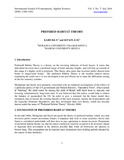| dc.description.abstract | Preferred Habitat Theory is a theory on the investing behavior of bond buyers. It states that individual investors have a preferred range of bond maturity lengths, and will only go outside of this range if a higher yield is promised. This theory also states that investors prefer shorter-term bonds to longer-term bonds. The preferred Habitat Theory is the modern interest theory explaining the yield curve. It was developed in the post Nixon era to meet the difficulties arising in the fiat currency systems. Modigliani and Sutch were primarily concerned with an empirical investigation of the effects of a particular policy of the US government and Federal Reserve, “Operation Twist”, which aimed at “twisting” the yield curve by raising the yield of bonds with short term to maturity and lowering simultaneously long-term rates. It was believed that this policy would help to reduce the balance of paymentsof the US. In order to give a rationale for the linear model they estimated, they reviewed the existing theories of the term structure, mainly the Expectations and the Liquidity Premium Hypothesis, and they developed their own theory, which has become known under the name of “Preferred Habitat Theory”.(Riedel, 2000) | en_US |

